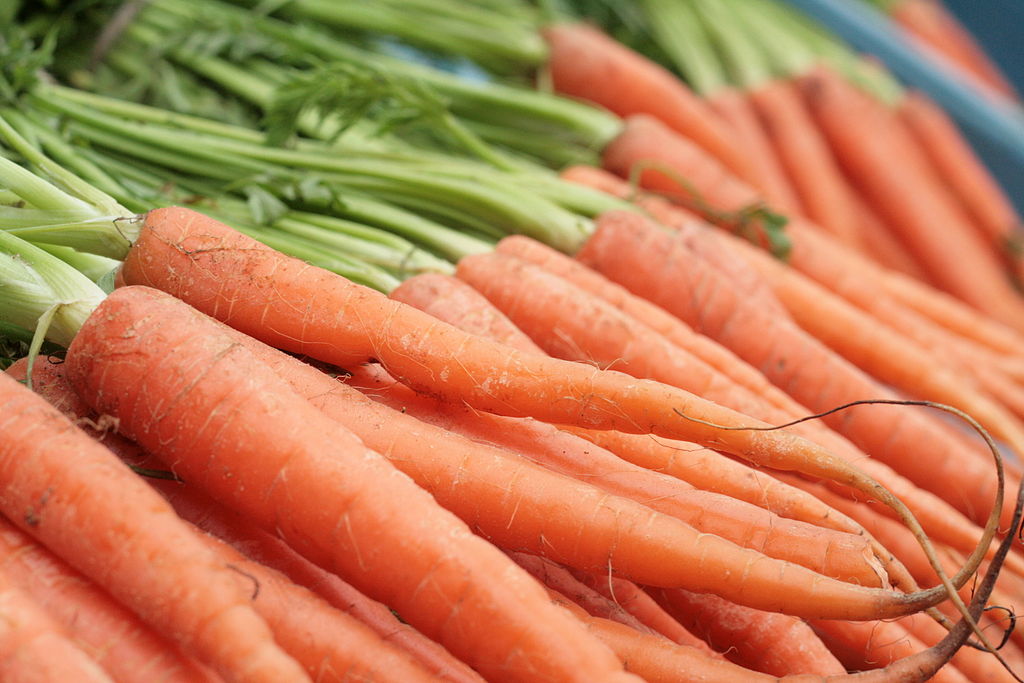Key Difference – Vitamin A vs. Beta Carotene
There seems to be a lot of confusion over the difference between vitamin A and beta carotene. Vitamin A is a fat-soluble vitamin and represents a group of unsaturated nutritional organic composites; that comprises retinol, retinal, retinoic acid, and several provitamin A carotenoids, and beta-carotene. Vitamin A is particularly significant for the health of the eyes, lungs, bones, skin, immune system, and protein synthesis. Beta-carotene is a pro-vitamin A and the most abundant and well-known carotene. This is the key difference between vitamin A and beta carotene. Beta-carotene is originated in the red, orange, and yellow colored fruits and vegetables. Pro-vitamin A (beta-carotene and other carotenes) can be converted in the human body into retinol (vitamin A). In this article, let’s elaborate the difference between vitamin A and beta-carotene in terms of their intended uses and other chemical characteristics.
What is Vitamin A?
Vitamin A (retinol) is a vitamin and is essential for life and overall health. It is a family of substances called pro-vitamin A and as pre-formed vitamin A. Preformed vitamin A is already formed as vitamin A and it comprises of various forms of retinol, retinal and retinoic acid. However, the word retinol is frequently used by scientists when referring to vitamin A. Preformed vitamin A is originated in nature only in animal products, such as fish and dairy products. Several pro-vitamin A includes carotenoids and beta-carotene, and they can be converted into pre-vitamin compounds inside the human body.
Vitamin A has numerous functions in the human body. It is significant for the growth and development, for the maintenance of the immune system as well as good vision. Vitamin A is required by the retina of the eye in the form of retinal, which reacts with protein opsin to synthesize rhodopsin, the light-sensitive molecule required for both low-light vision and color vision. In addition to that, an irreversibly oxidized form of retinol or retinoic acid has a very different which is an essential hormone-like growth factor for epithelial and other cells. Retinol and other pre-forms are metabolized in the body and stored in the liver, principally as retinyl palmitate. Vitamin A in the bloodstream is known as serum retinol and is assessed in “retinol equivalents”.

What is Beta Carotene?
Beta-carotene is a very strong colored red-orange pigment plentiful in various edible plants and fruits. It is an organic complex and is chemically categorized as a hydrocarbon and precisely as a terpenoid, replicating its derivation from isoprene units. It is a tetraterpene and a fellow of the carotenes. Carotenes are synthesized biochemically from eight isoprene units and thus having 40 carbons. Amongst this overall class of carotenes, beta-carotene is the well-known by having beta-rings at both ends of the long chain molecule. Beta-carotene is rich in carrots, pumpkins, and sweet potatoes that contribute to their orange colour. In addition to that, beta-carotene is a pro-vitamin A and two molecules of retinol (pre-vitamin A) can be synthesized from one molecule of beta-carotene.

What is the difference between Vitamin A and Beta Carotene?
Vitamin Group:
Vitamin A is a fat-soluble vitamin. It is a group of unsaturated nutritional organic compounds; that comprises retinol, retinal, retinoic acid, and several provitamin A carotenoids, and beta-carotene.
Beta-carotene is a provitamin A.
Chemical Structure:
All types of vitamin A have a beta-ionone ring to which an isoprenoid chain is attached, known as a retinyl group. This is vital for vitamin activity.
Beta-carotene has two connected retinyl groups.
Synthesis:
Vitamin A cannot be converted into beta-carotene.
Beta-carotene can be converted into vitamin A. One molecule of beta-carotene can produce two molecules of retinol. The enzyme beta-carotene 15,15′-dioxygenase cleaves beta-carotene in the intestinal mucosa and converts it to retinol. This conversion efficiency is low due to the very poor solubility of beta-carotene in digestive tract medium. Therefore, 12 mg of beta-carotene is required to produce 1 mg of retinol.
Source:
When speaking of Vitamin A, Retinol is mainly found in animal food sources such as yellow and fat-soluble food substance. It is rich in cod liver oil, liver, milk, butter, and eggs.
Beta-carotene directly contributes to the orange color of many different fruits and vegetables. Crude palm oil, as well as yellow and orange fruits, such as cantaloupe, mangoes, pumpkin and papayas, and orange, root vegetables such as carrots and yams are particularly rich sources of beta-carotene. The color of beta-carotene is masked by chlorophyll pigments in green leafy vegetables and edible green leaves such as spinach, kale, sweet potato leaves, and sweet gourd leaves. Therefore, they are also rich in beta-carotene.
Significance:
Vitamin A is important for vision cycle, maintenance of the immune system, growth and development, gene transcription, embryonic development, and reproduction, Bone metabolism and antioxidant activity
Beta-carotene is used in nutritional supplements as a pro-vitamin A. It is a powerful antioxidant. Also, it is an orange color pigment and used as a color additive. It’s E number E160a.
Side Effects:
Excessive vitamin A consumption can cause nausea, petulance, reduced appetite, vomiting, blurry vision, nuisances, hair loss, muscle and stomach pain and weakness, sleepiness, and changed mental status.
The most common side effect of excessive β-carotene consumption is carotenoderma (orange skin)
In conclusion, vitamin A and beta-carotene are essential nutrients to the human body. Vitamin A is an essential fat-soluble vitamin that is synthesized from beta-carotene. Beta-carotene has different food applications, and it is a pro-vitamin A.
References
Aktkuna D, et al., Beta-carotene, vitamin A and carrier proteins in thyroid processes.ActaMedicaAustriaca, 1993;20 (1-2):17-20.
Radhika MS, et al. Effects of vitamin A deficiency during pregnancy on maternal and child health.Brit J Gyn, (2002) Jun;109(6):689-93.
Sklan D. Vitamin A in human nutrition. Progressive Food and Nutrition Sciences, 1987;11(1):39-55.
Image Courtesy:
1. Retinol By Dwmyers (en:Image:Retinol.png) [GFDL or CC-BY-SA-3.0], via Wikimedia Commons
2. “Carrots” by Kander – Own work. [Public Domain] via Commons
ncG1vNJzZmivp6x7pbXFn5yrnZ6YsqOx07CcnqZemLyue8OinZ%2Bdopq7pLGMm5ytr5Wau27CyK2YpqGeYq5urc2dZK%2BrXZeyta2MnJirp6Sau6Z7